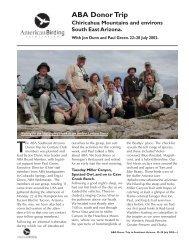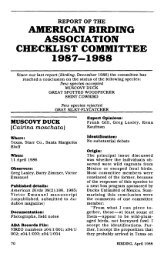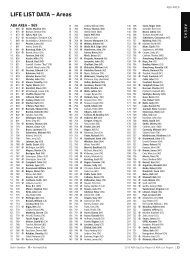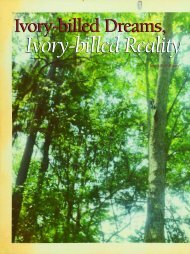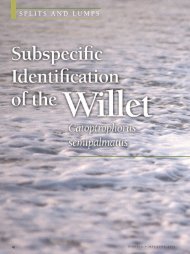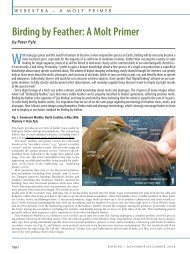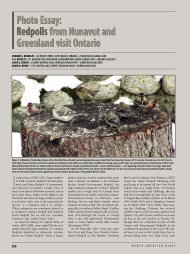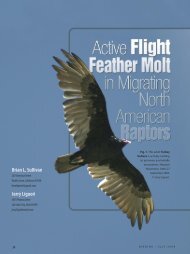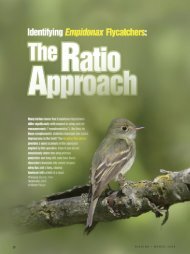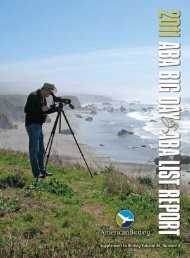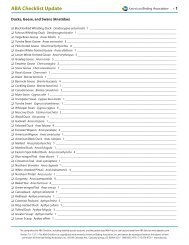A Gray Kingbird in Nova Scotia, and the Perils of Online Identification
A Gray Kingbird in Nova Scotia, and the Perils of Online Identification
A Gray Kingbird in Nova Scotia, and the Perils of Online Identification
Create successful ePaper yourself
Turn your PDF publications into a flip-book with our unique Google optimized e-Paper software.
that we tested <strong>the</strong> statistical “fit” <strong>of</strong> <strong>the</strong> Lanark bird to <strong>the</strong> respectivec<strong>and</strong>idate species. For technical reasons, <strong>the</strong> ratioswere first transformed as arcs<strong>in</strong>e square roots; <strong>the</strong>n, means <strong>and</strong>st<strong>and</strong>ard deviations (SD) estimated for each <strong>in</strong>ternet sample<strong>of</strong> ten birds. These transformed estimates are as follows: for<strong>Gray</strong> <strong>K<strong>in</strong>gbird</strong>, mean=1.04, SD=0.024; for Ash-throated Flycatcher,mean=1.12, SD=0.029. The Lanark bird, with a transformedratio <strong>of</strong> 1.03, lies with<strong>in</strong> about 0.6 SD <strong>of</strong> <strong>the</strong> samplemean for <strong>Gray</strong> <strong>K<strong>in</strong>gbird</strong>; however, it is more than 3.3 SDs from<strong>the</strong> sample mean for Ash-throated Flycatcher. On this basis,<strong>the</strong> Lanark bird is not far from average for <strong>Gray</strong> <strong>K<strong>in</strong>gbird</strong>, butit has a less than 1% probability <strong>of</strong> be<strong>in</strong>g an Ash-throated Flycatcherbased on our measurements alone.e believe that field observations <strong>and</strong> digital images stronglysupport records <strong>of</strong> <strong>Nova</strong> <strong>Scotia</strong>’s first confirmed (<strong>and</strong> thirdreported) <strong>Gray</strong> <strong>K<strong>in</strong>gbird</strong> <strong>and</strong> third confirmed Ash-throatedFlycatcher <strong>in</strong> mid-November 2010. Intrigu<strong>in</strong>gly, but not implausibly,both are from <strong>the</strong> same yard on <strong>the</strong> same date. Theoccurrence <strong>of</strong> <strong>the</strong>se birds re<strong>in</strong>forces <strong>the</strong> lesson that low-resolutionimages <strong>of</strong> “ill-posed” rare birds can be mislead<strong>in</strong>g. Inthis digital era, photo documentation <strong>of</strong> rare birds is easy, <strong>and</strong>photo confirmation <strong>of</strong> <strong>the</strong>ir identifications <strong>of</strong>ten seemsstraightforward. As <strong>the</strong> Lanark flycatchers show, however, oldfashionedcritical analysis may still be required for <strong>the</strong> correctidentification <strong>of</strong> vagrants.Literature CitedArmistead, G. L. <strong>and</strong> M. J. Iliff. 2003. The vagrancy <strong>of</strong> <strong>Gray</strong> <strong>K<strong>in</strong>gbird</strong> <strong>in</strong>North America. North American Birds 57:148–161.Bannon, P., O. Barden, N. David, S. Denault, <strong>and</strong> Y. Aubry. Fall migration–Augustthrough November 2006: Québec. North AmericanBirds 61:33–35.Lee, C.-T., A. Birch, <strong>and</strong> T. L. Eubanks. 2008. Field identification <strong>of</strong> Western<strong>and</strong> Eastern wood-pewees. Bird<strong>in</strong>g 40(4):34–40.Lehman, P. 2008. Bird<strong>in</strong>g <strong>and</strong> <strong>the</strong> <strong>in</strong>ternet: The dark side. Bird<strong>in</strong>g40(1):36–40.McLaren, I. A. 1996. Acadian Flycatcher <strong>in</strong> <strong>Nova</strong> <strong>Scotia</strong>. Birders Journal5:194–195.Pyle, P. 1997. <strong>Identification</strong> Guide to North American Birds. Part I.Columbidae to Ploceidae. Slate Creek Press, Bol<strong>in</strong>as.Rowl<strong>and</strong>, F. 2009. Identify<strong>in</strong>g Empidonax flycatchers: The ratio approach.Bird<strong>in</strong>g 41(2):31–38.Smith, G. A. <strong>and</strong> J. A. Jackson. 2002. <strong>Gray</strong> <strong>K<strong>in</strong>gbird</strong> (Tyrannus dom<strong>in</strong>icensis),<strong>in</strong>: Birds <strong>of</strong> North America, ed. by A. Poole. Cornell Lab <strong>of</strong> Ornithology,Ithaca .W W W . A B A . O R G 33



